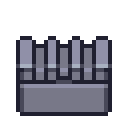Atmospheric Technician
WIP
Engineering Department
Atmospheric Technician
- Access: Engineering, Atmospherics, External, Maintenance
- Difficulty: Hard
- Duties: Manage the station's various gases. Restore breathable atmosphere to depressurized areas. Ensure the station's air remains at livable conditions.
- Supervisors: Chief Engineer, Captain
- Subordinates: None
- Guides: [TBA]
Much like your engineering counterpart, the Station Engineer, your job is to fix, maintain, and improve the station's air quality. By working on various pipes, pumps, and vents insure that the hallways remain breathable. Most of the time your job will be to sit back relax in your department until the inevitable hull breach occurs depressurizing the hallways. When this happens don your hardsuit and magboots, turn on your internals, and work with the engineers to patch up the hole. Ensure that the atmosphere in the recently breached area is livable once again with your Gas Analyzer. Once the air quality is back to standards, return to your department to relax or experiment with the pipes until the next inevitable hull breach occurs.
Your supervisor is Chief Engineer.
Atmosia
Atmospherics, or sometimes referred to as Atmosia, is where you will be spending most of your time. In this jungle of pipes and vents is where the magic of atmospherics happens. Make sure to stare at the pipes until they begin to make sense. Observe where the distro and waste loops are. Once you feel comfortable with the layout feel free to tweak the pipes and vents to your likening. Reroute the layout to a more efficient set up or experiment with gases in the mix chamber.
Distro
Distro, or the distribution loop, is usually marked with light blue pipes and is responsible for distributing gas to the station via vents. These pipes start and end in atmospherics and are looped around the entire station. The main purpose of Distro is to ensure that the station maintains a constant pressure of breathable air. At round start, Distro will be fully automated and connected to only the nitrogen and oxygen tanks.
Waste
Waste, or the waste loop, is usually marked with red pipes and is responsible for removing waste gas around the station via scrubbers. These pipes start and end in atmospherics and are looped around the entire station. The main purpose of the waste loop is the ensure that harmful gases get removed from the stations atmosphere. Scrubbers will remove gas from the hallways and return it to Atmospherics where it will then be filtered into various holding chambers. Gases will be filtered out. Harmful gases will be deposited into their assigned chambers and the breathable air will once again make its way back to Distro and into the station to continue the cycle.
Gas Miners
Gas miners create new gas from nothing and are solely used to make sure the station has an infinite amount of a specific gas. Gas Miners come in different types and create different types of gas. A oxygen miner will create oxygen gas while a plasma miner will create plasma gas. Gas Miners can be found in Atmospherics inside each gas holding chamber.
Useful trivia and tricks
- always be prepared to fix a breach. Carry your Atmospherics hardsuit or firesuit with you so you can survive long enouth to fix any breach at a moments notice.
- the Atmospherics firesuit is space proof and functions like a hardsuit. Just make sure you wear the helmet with it or else it wont give you any protection.
- The standard air mix is 21% oxygen and 82% nitrogen @ 101.7 kPa at 293.2K (20°C).
- Overpressurization can be just as harmful as depressurization!
- Make sure that the distro loop never connects to anything else like the mix or waste loop. unless you want to flood the station with superheated plasma and risk getting an angry admin message.

